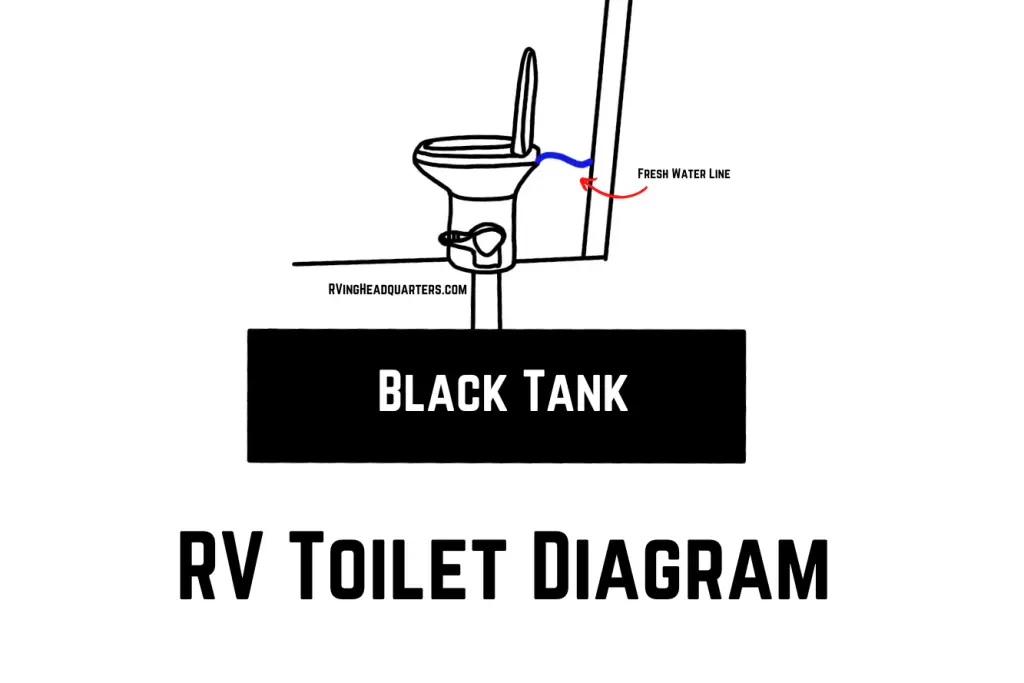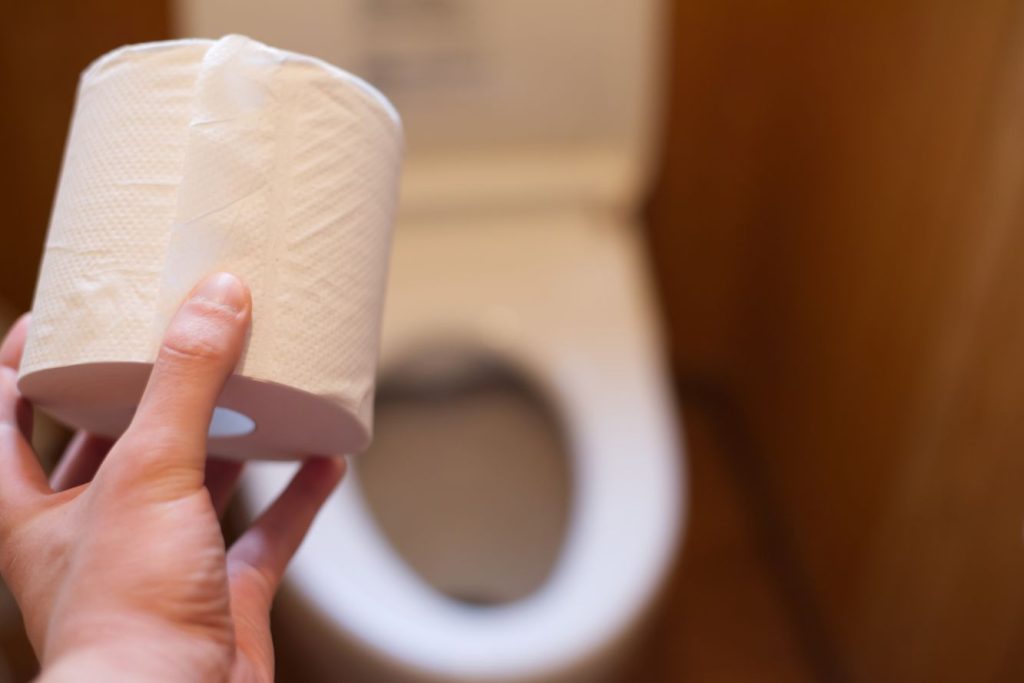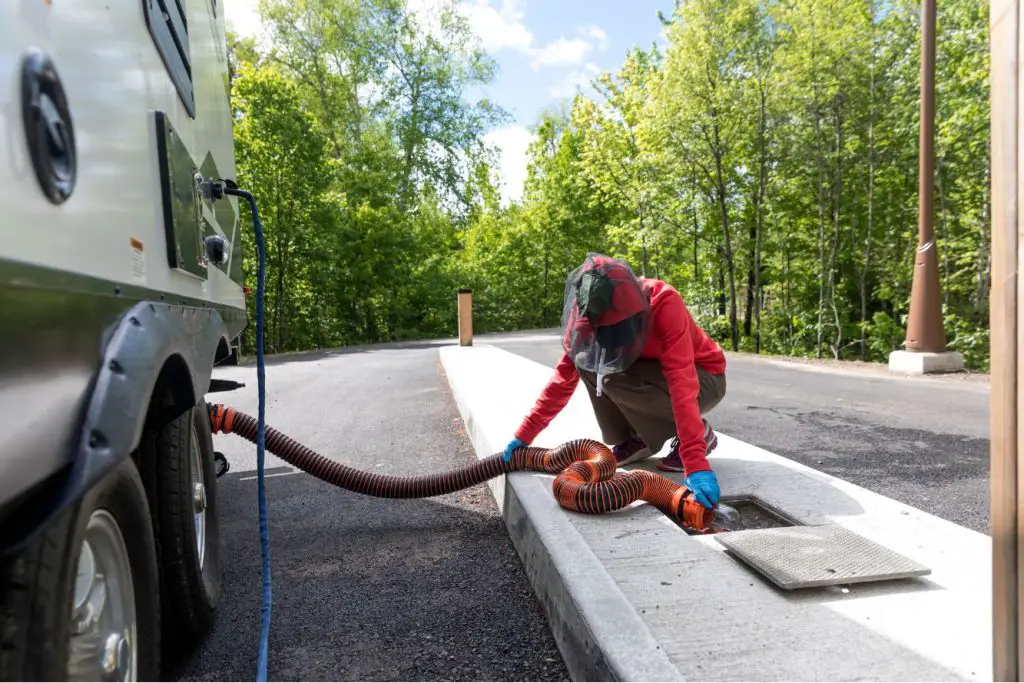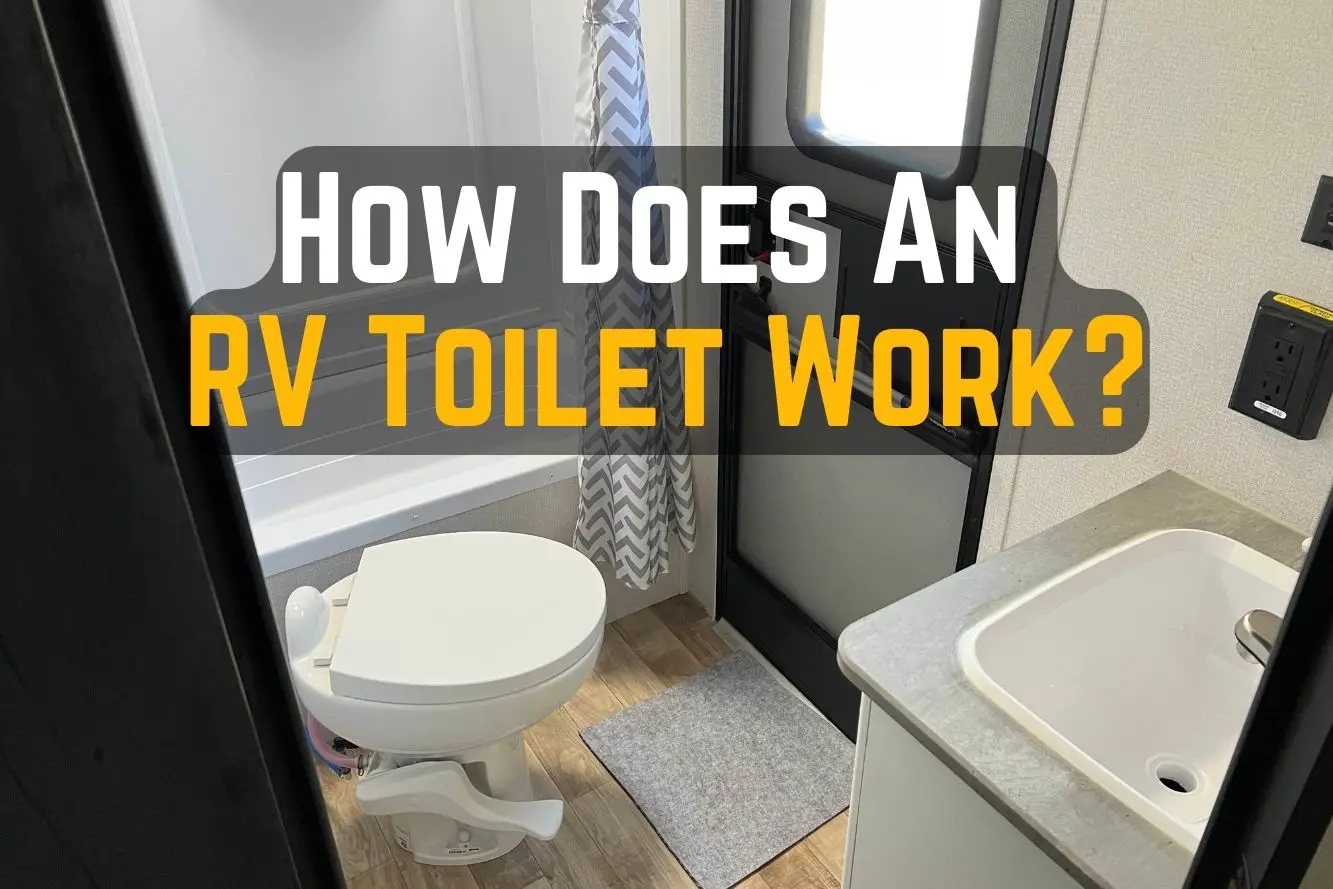How does an RV toilet work? It’s simple, but it’s a lot different than the residential toilets you might be used to.
RV toilets have a simple plumbing system that allows you to use your RV bathroom just like a regular bathroom. And yes, you can even poop in your RV toilet.
In this article, we are taking a deep dive into RV toilets. You’ll learn:
- How they work
- How to use them
- How to clean and maintain them
- Answers to FAQ
And so much more. Let’s get started.
Table of Contents
How Does an RV Toilet Work? (Standard RV Toilets)
Although RV toilets look similar to standard residential toilets, they function in a much different way. A standard RV toilet is a gravity-flush toilet. However, instead of flushing into a plumbing pipe, they flush directly into the RV black tank where the sewage remains until it is emptied at an RV dump station.
Similar to residential toilets, RV toilets have a bowl that holds water, a pedestal, a toilet seat, and a flushing mechanism. That’s where the similarities end, though! Let’s take a look at the components of a standard RV toilet.
Components Of An RV Toilet

The standard RV toilet that comes stock in most US RVs is made from either porcelain or a hard type of plastic.
It has a pedestal that rises up off the floor and is connected to the toilet bowl which has a toilet seat and lid.
Unlike residential toilets, an RV toilet doesn’t have a water tank on the back. Instead, the toilet receives water from a pipe behind the toilet that comes out from the wall.
One major difference with an RV toilet bowl is the flap in the bottom. All standard RV toilets have a flap with a rubber gasket that seals the toilet bowl. This seal is water-tight and air-tight. The purpose of this seal is to hold water in the bowl and to prevent odors from coming into the RV from the black tank.
There isn’t a standard flushing handle on an RV toilet. Instead, most standard RV toilets have a foot-pedal flushing mechanism. Pressing the pedal halfway allows water to fill the toilet bowl, and pressing it all the way opens the flap to flush the toilet.
Lastly, some RV toilets also have a sprayer. The sprayer is a handheld sprayer that can be used as a bidet and as a toilet bowl cleaner.
How to Use an RV Toilet
Using an RV toilet might feel tricky the first couple of times, but you’ll get the hang of it fast.
The most important things to keep in mind about your RV toilet are:
- Use plenty of water to flush – more than you think you’ll need.
- Use RV-safe toilet paper or put your toilet paper in the trash instead.
- Never put anything in the RV toilet other than waste and RV-safe toilet paper.
The reason you need to use more water than you think you’ll need is to prevent clogs in your RV black tank.
Clogs are one of the most common and grossest complications facing RVers, and most of the time they happen because not enough water is used in the toilet.
If you don’t want to use RV safe toilet paper, discard your toilet paper in the trash instead of putting it into the toilet. Also, you should never flush anything other than waste and RV-safe TP – not even feminine products.
Here’s how to use your RV toilet.
- Depress the toilet pedal halfway to add water to the toilet bowl. For peeing only, you don’t need as much water. For poop, fill the toilet bowl ⅓ or more with water.
- Use the toilet.
- If necessary, depress the pedal halfway again to add more water to the toilet bowl.
- When you are ready, press the pedal down all the way to flush the toilet.
- Continue holding the pedal for 10-20 seconds to allow plenty of water to flush into the tank.
- Let up on the pedal so that the toilet flap closes and add about 1-2 inches of water to the bowl. This helps keep the rubber gasket hydrated and adds a water barrier to prevent odor.
Do You Really Need Special RV Toilet Paper?

Yes, you actually do need RV-safe or septic-safe toilet paper if you plan to flush your toilet paper.
RV-safe and septic-safe toilet papers are specifically engineered to break down quickly in your holding tank. This helps to prevent RV black tank clogs and waste buildup.
If you do end up with buildup in your RV tank, you can learn to how to get rid of dried waste in your RV tank here.
If you don’t want to part with your ultra-thick and plush toilet paper, you don’t have to. You can always use a dedicated trash can in your RV bathroom for disposing of your toilet paper.
Where RV Toilet Waste Goes – Your RV Black Tank
So – where does the water go in an RV toilet? When you flush your RV toilet, the waste and water goes directly into your RV black tank. The RV black tank is a waste holding tank mounted underneath your RV and situated directly below your toilet.
Essentially, the waste and water falls directly into the black tank with the help of gravity.
How the RV Black Tank Works
Your RV black tank holds waste water from your RV toilet – aka sewage. This tank is a vital part of your RV plumbing system. Your RV toilet is the only thing that’s connected to your black tank.
That’s why it’s so important to make sure to use plenty of water every time you flush! The more water in your black tank, the better. More water helps dissolve and liquify toilet paper and waste to help prevent clogs and make dumping a breeze.
On the exterior of the RV, the black tank has a large pipe to hook up an RV sewer hose when it’s time to dump the tank. This area is often called the sanitation station.
The pipe is sealed with an RV waste valve or RV gate valve. This valve seals with a rubber gasket and can be opened with a pull handle.
Never pull your RV black tank gate valve unless your sewer hose is securely connected to your RV and to an open sewer dump site.
Many black tanks these days are also equipped with a black tank flush system. A black tank flush system is located in the RV sanitation station and allows you to connect a water hose to spray water into the tank and rinse it after you dump.
How Often Do You Need to Dump Your RV Black Tank?
Your black tank will need dumped anywhere between every 3-5 days to up to 2 weeks or longer. How long you should go before dumping your tank depends on several factors.
- The size of your black tank.
- How many people are using the bathroom in your RV.
- How often the bathroom is used in your RV.
- The length of your camping trip.
If you are only out camping for the weekend, you should dump and rinse your black tank before putting your RV back in storage.
Otherwise, it’s always recommended to wait until the tank is at least ⅔ full before dumping to avoid clogs and build up.
Important: Always keep your black tank closed until it’s time to dump or at least ⅔ full. Leaving your black tank open will cause the formation of an RV poop pyramid, which is a very difficult type of RV clog that can take days to weeks to fix.
Dumping the RV Black Tank

When it’s time to dump the RV black tank, you’ll need an RV sewer hose, a clear elbow attachment, and an RV dump station.
Some campsites have sewer hookups – so if you’re in one of those, you don’t have to move!
Learning how to dump your RV tanks deserves it’s own post, but here’s a breakdown of dumping the RV black tank.
- Hook up your RV sewer hose to your RV sanitation station drain pipe. Give it a wiggle or a tug to be sure it’s secure. I’ve had a sewer hose pop off while dumping… That was one of the top grossest things I’ve ever dealt with in my life.
- Securely attach the other end of your RV sewer hose into the sewer drain on the ground. Use a RV sewer donut, a sewer hose weight, a large rock, or have someone hold their foot on it to keep it secure.
- Once you are sure your connections are totally secure, start by slowly opening your black tank waste valve. Don’t just open it all the way at the start. Start slow until it’s all the way open.
- Allow the tank to drain completely, then close the valve and run the black tank flush and drain again. Repeat until the water coming out of the tank is clear and free of debris.
- If you don’t have a black tank flush, you can close the tank and fill with fresh water from the toilet or a hose. This can a while, but you must clean your tank.
- After you are done emptying your black tank, empty the gray tank. This helps to rinse out your RV sewer hose of any remaining sewage.
- Rinse your hose and supplies and put them away and you’re done!
Common RV Toilet Chemicals – Do You Really Need Them?
There are a lot of different chemicals on the market to add to your RV black tank. Some are made from chemicals, while others are made from natural enzymes of bacteria that eat the waste to break it down.
But do you really need RV toilet chemicals? While this is largely a personal preference, we always recommend using natural enzymatic RV toilet additives to help break down the waste in your black tank.
The purpose of these chemicals is to break down waste to avoid clogs and help eliminate some of the odor associated with the waste tank.
And anything you can do to avoid and prevent clogs is a good idea!
Maintaining Your RV Toilet & Black Tank
Maintaining your RV toilet and black tank is key to keeping them in great working order. Keeping them clean and maintained will help prevent clogs and buildup, prevent odors, and keep your black tank sensors working properly.
Toilet maintenance tips:
- Use plenty of water when flushing.
- Always keep 1”-2” of water in the toilet bowl to keep the seal moisturized.
- Clean your toilet with non-caustic cleaners like soap and water or white vinegar. Never use caustic chemicals as these can damage your toilet and tank.
Black tank maintenance tips:
- Fully rinse your tank every time you dump.
- Use a natural holding tank additive like Unique to help break down waste.
- Only use RV-safe toilet paper.
- Always keep your black tank closed until it’s full or time to dump.
Other Types of RV Toilets
While this article focuses on how standard RV toilets work, there are several other types of RV toilets.
You can learn more about these other types of toilet and how they work here on RVing Headquarters.
- Composting toilets
- Cassette toilets
- Portable camping toilets
- Dry Flush toilets
- Incinerating toilets
- Macerating toilets
The most common types of RV toilets that come with an RV are standard gravity-flush toilets, cassette toilets, and portable camping toilets.
However, all of these toilets in this list are options for RVs and vans (and even tents) and they each have their own pros and cons.
Related: Can You Put A Regular Toilet In Your RV? The RV Toilet Debate SOLVED
FAQ About How RV Toilets Work
Let’s dive into some FAQ before wrapping up!
Do RV Toilets Have P-Traps?
No, RV toilets do not have P-traps. In residential toilets, a P-trap helps hold water in the toilet bowl.
An RV toilet drain pipe is straight and goes right into the black tank. The lack of a curve helps prevent clogs in the RV toilet.
Can I Use My RV Toilet Without Water?
Unless you have a waterless toilet, you shouldn’t use your RV toilet without water.
Water is essential for the proper function of an RV toilet. Without water, your waste will go into your RV holding tank and dry out. This will cause huge clogs like the dreaded RV poop pyramid.
Always use water – and lots of it. Use more water than you think you’ll need.
Should I Leave My Black Tank Open or Closed?
You should never leave your black tank open, even if you have full hookups at your campsite. Your black tank needs liquid to function properly.
If you leave the valve open, the liquid will drain out but the solid waste like poop and paper will remain. The solid waste will dry out and solidify. Over time, it builds up into a literal pyramid (called the poop pyramid). This pyramid of waste can reach all the way to your toilet! And the only way to remove it is by soaking it for several days and draining your tank over and over again.
To summarize: always keep your black tank closed until the tank is ⅔ full or fuller to prevent clogs and buildup.
Should Toilet Paper Go In The RV Toilet?
You can flush RV-safe and septic-safe toilet paper in your RV toilet. These types of toilet paper are specifically engineered to break up in your holding tank. Never use any other kind of toilet paper in your RV toilet as it will create clogs and build up.
How Long Can Black Water Stay In My RV Tank?
Black water (aka sewage) can remain in your RV black tank until it’s time to dump. For some RVers, that’s only a few days. For others it can be a couple of weeks or longer.
If you are a weekend or part-time camper, it’s best to dump and completely rinse your black tank before putting your RV in storage. Leaving waste in the black tank for a long time can cause it to dry out and turn into a sludge that is difficult to remove.
But if you’re on an extended camping trip, you only need to dump it once it gets full.

